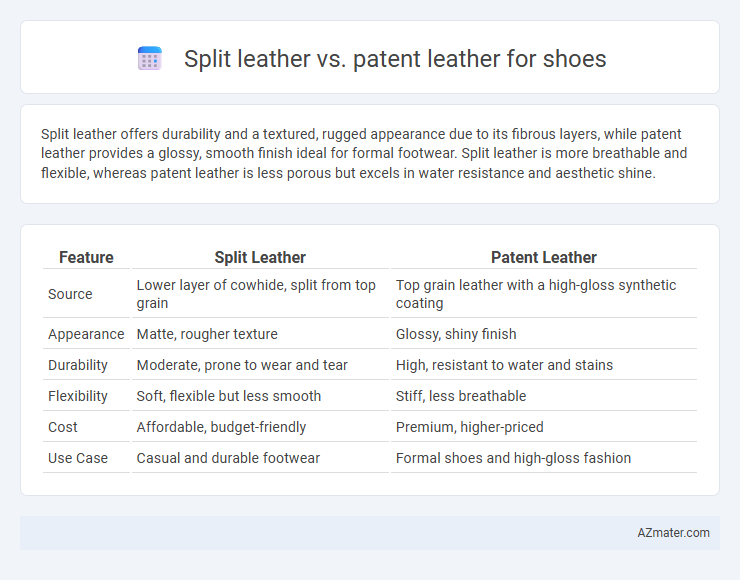Split leather offers durability and a textured, rugged appearance due to its fibrous layers, while patent leather provides a glossy, smooth finish ideal for formal footwear. Split leather is more breathable and flexible, whereas patent leather is less porous but excels in water resistance and aesthetic shine.
Table of Comparison
| Feature | Split Leather | Patent Leather |
|---|---|---|
| Source | Lower layer of cowhide, split from top grain | Top grain leather with a high-gloss synthetic coating |
| Appearance | Matte, rougher texture | Glossy, shiny finish |
| Durability | Moderate, prone to wear and tear | High, resistant to water and stains |
| Flexibility | Soft, flexible but less smooth | Stiff, less breathable |
| Cost | Affordable, budget-friendly | Premium, higher-priced |
| Use Case | Casual and durable footwear | Formal shoes and high-gloss fashion |
Introduction to Split Leather and Patent Leather
Split leather originates from the fibrous layer beneath the top grain of animal hide, offering enhanced flexibility but typically lower durability compared to full-grain leather, making it a popular choice for affordable shoes. Patent leather is known for its glossy, high-shine finish achieved through a coating process, providing a sleek, formal appearance and better water resistance, commonly used in dress shoes. Understanding the distinct textures and properties of split and patent leather helps in selecting the right material for shoe style, durability, and maintenance preferences.
Understanding Split Leather: Features and Benefits
Split leather, derived from the lower layers of animal hide, offers a unique balance of durability and affordability for shoe manufacturing. Its porous structure allows for excellent breathability and flexibility, making it a comfortable choice for daily wear. While less glossy than patent leather, split leather provides a matte finish that is versatile and suitable for casual and semi-formal footwear styles.
Defining Patent Leather: Characteristics and Advantages
Patent leather features a high-gloss finish achieved through a coating of lacquer or varnish, giving shoes a shiny and polished appearance. This material is water-resistant, easy to clean, and maintains its bright surface without cracking or peeling, making it ideal for formal and dress shoes. In contrast to split leather, patent leather offers enhanced durability and aesthetic appeal, with less maintenance required to preserve its sleek look.
Manufacturing Processes: Split Leather vs Patent Leather
Split leather is produced by splitting the fibrous part of the hide after the top grain is removed, resulting in a more porous and less durable material often used for suede or coated finishes. Patent leather undergoes a specialized manufacturing process where the leather surface is coated with a high-gloss synthetic finish, typically polyurethane or acrylic, providing a shiny, waterproof exterior. This coating process not only enhances durability and stain resistance but also requires precise curing and polishing steps to achieve the trademark glossy appearance of patent leather shoes.
Durability and Performance Comparison
Split leather, derived from the lower layers of the hide, offers moderate durability and a matte finish but is more prone to wear and moisture absorption compared to patent leather. Patent leather features a high-gloss, coated surface that enhances water resistance and maintains its sleek appearance longer, making it more durable in wet or abrasive conditions. For shoe performance, patent leather provides superior protection and easier cleaning, while split leather requires more maintenance to prevent damage and retain its look.
Aesthetic Appeal and Surface Finish
Split leather features a textured, matte finish that offers a rugged, natural aesthetic ideal for casual or vintage shoe styles, while patent leather boasts a high-gloss, mirror-like surface that delivers a sleek, polished look suited for formal and dress shoes. The porous nature of split leather allows for more breathability and a softer feel but results in a less uniform appearance compared to the smooth, reflective coating of patent leather created by applying a lacquer or plastic layer. Choosing between the two depends on the desired shoe style, with split leather emphasizing durability and rustic charm, and patent leather emphasizing elegance and shine.
Comfort and Breathability Factors
Split leather offers greater breathability and comfort for shoes due to its porous structure, allowing better air circulation and moisture absorption. Patent leather, although stylish with its glossy finish, is less breathable and can cause feet to feel hotter and sweatier during prolonged wear. Choosing split leather enhances foot comfort in warm conditions, while patent leather prioritizes appearance over ventilation.
Maintenance and Care Requirements
Split leather requires regular conditioning and protection from moisture to prevent drying and cracking, as its porous texture absorbs oils and dirt more easily. Patent leather demands minimal maintenance, needing only occasional wiping with a damp cloth and polishing with a patent leather cleaner to preserve its glossy finish. Proper storage away from direct sunlight and heat sources is crucial for both types to maintain their durability and appearance.
Cost Differences: Split Leather vs Patent Leather
Split leather shoes generally cost less than patent leather shoes due to the lower quality and durability of split leather, which is made from the fibrous part of the hide beneath the top grain. Patent leather, featuring a glossy, coated finish created through multiple layers of lacquer, tends to have higher production costs that increase its retail price. Consumers opting for patent leather often pay a premium for its sleek appearance and water-resistant properties compared to the more affordable but less durable split leather options.
Best Uses and Recommendations for Shoe Buyers
Split leather offers durability and breathability, making it ideal for casual shoes and boots that require flexibility and comfort. Patent leather is best suited for formal and dress shoes due to its shiny, polished finish, which resists water and stains but lacks breathability. Shoe buyers should choose split leather for everyday wear and long-lasting casual footwear, while patent leather is recommended for occasions demanding sleek, stylish appearances.

Infographic: Split leather vs Patent leather for Shoe
 azmater.com
azmater.com